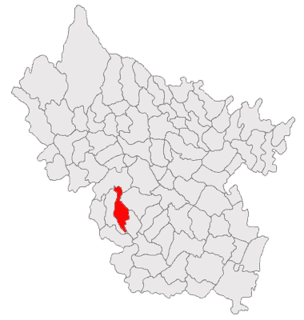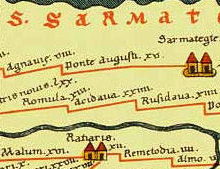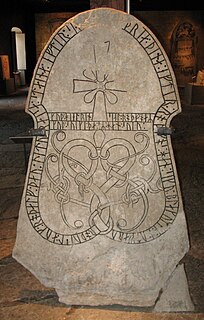
Dacia was the land inhabited by the Dacians. The Greeks referred to them as the Getae and the Romans called them Daci.
Kaloyan or Kalojan, also known as Ioannitsa or Johannitsa, was emperor or tsar of Bulgaria from 1196 to 1207. He was the younger brother of Theodor and Asen, who led the anti-Byzantine uprising of the Bulgarians and Vlachs in 1185. The uprising ended with the restoration of Bulgaria as an independent state. He spent a few years as a hostage in Constantinople in the late 1180s. Theodor, crowned Emperor Peter II, made him his co-ruler after Asen was murdered in 1196. A year later, Peter was also murdered, and Kaloyan became the sole ruler of Bulgaria.

Gelou was the Vlach ruler of Transylvania at the time of the Hungarian conquest of the Carpathian Basin around 900 AD, according to the Gesta Hungarorum. Although the Gesta Hungarorum, which was written after 1150, does not indicate the enemies of the conquering Hungarians (Magyars) known from earlier annals and chronicles, it refers to local rulers—including Gelou—who are not mentioned in other primary sources. Consequently, historians debate whether Gelou was a historical person or an imaginary figure created by the unidentified author of the Gesta Hungarorum. In Romanian historiography, based on the mention of him by Anonymus some 300 years later, Gelou is considered one of three early-10th-century Romanian dukes with lands in the intra-Carpathian region of present-day Romania.
Ivan Asen I, also known as Asen I or John Asen I, was emperor or tsar of Bulgaria from 1187/1188 to 1196 as co-ruler with his elder brother, Peter II. Hailing from the Byzantine theme of Paristrion, his exact place and date of birth are unknown. Although most contemporaneous chronicles describe Asen and his brothers, Theodor (Peter) and Kaloyan, as Vlachs, they were probably of mixed Vlach, Bulgarian, and Cuman ancestry.

Boril was the emperor (tsar) of Bulgaria from 1207 to 1218. He was the son of an unnamed sister of his predecessor, Kaloyan and Kaloyan's brothers, Peter II and Ivan Asen I, who had restored the independent Bulgarian state. After Kaloyan died unexpectedly in October 1207, Boril married his widow, a Cuman princess and seized the throne. His cousin, Ivan Asen, fled from Bulgaria, enabling Boril to strengthen his position. His other kinsmen, Strez and Alexius Slav, refused to acknowledge him as the lawful monarch. Strez took possession of the land between the Struma and Vardar rivers with the support of Stefan Nemanjić of Serbia. Alexius Slav secured his rule in the Rhodope Mountains with the assistance of Henry, the Latin Emperor of Constantinople.

Pietroasele is a commune in Buzău County, Muntenia, Romania, known for its vineyards. The name means "the rockies". The commune is composed of six villages: Câlțești, Clondiru de Sus, Dara, Pietroasa Mică, Pietroasele and Șarânga. It became famous with the discovery in 1837 of the Pietroasa Treasure composed of several pieces of gold and precious stones. The Romanian historian Alexandru Odobescu wrote a book on the archaeological discovery.
Peter II, born Theodor, also known as Theodor-Peter, was the first emperor or tsar of the restored Bulgarian Empire from 1185 to 1197. He hails from the Byzantine theme of Paristrion, although his exact place and date of birth are unknown. He and his younger brothers, Asen and Kaloyan, were mentioned as Vlachs in most foreign contemporaneous sources, but they were probably of a mixed Vlach, Bulgarian, and Cuman origin.

The Early Middle Ages in Romania started with the withdrawal of the Roman troops and administration from Dacia province in the 270s. In the next millennium a series of peoples, most of whom only controlled two or three of the nearly ten historical regions that now form Romania, arrived. During this period, society and culture underwent fundamental changes. Town life came to an end in Dacia with the Roman withdrawal, and in Scythia Minor – the other Roman province in the territory of present-day Romania – 400 years later. Fine vessels made on fast potter's wheels disappeared and hand-made pottery became dominant from the 450s. Burial rites changed more than once from cremation to inhumation and vice versa until inhumation became dominant by the end of the 10th century.
Caucaland is a region mentioned by Roman historian Ammianus Marcellinus as Caucalandenses locus, a place where the Goths located on the left bank of the Danube withdrew after the coming of the Huns. It is identified by some modern historians as Valea Strâmbă River (Mureş), and by Florin Constantiniu in Vrancea and Buzău Mountains.

Brazda lui Novac is a Roman limes in present-day Romania, known also as Constantine's Wall. It is believed by some historians like Alexandru Madgearu to border Ripa Gothica.

Acidava (Acidaua) was a Dacian and later Roman fortress on the Olt river near the lower Danube. The settlements remains are located in today's Enoşeşti, Olt County, Oltenia, Romania.
The Catepanate of Ras was a province (catepanate) of the Byzantine Empire, established around 971 in central regions of early medieval Serbia, during the rule of Byzantine Emperor John Tzimiskes (969–976). The catepanate was named after the fortified town of Ras, eponymous for the historical region of Raška. The province was short-lived, and collapsed soon after 976, following the Byzantine retreat from the region after the restoration of the Bulgarian Empire.
Ivan Asen II, also known as John Asen II, was Emperor (Tsar) of Bulgaria from 1218 to 1241. He was still a child when his father Ivan Asen I – one of the founders of the Second Bulgarian Empire – was killed in 1196. His supporters tried to secure the throne for him after his uncle, Kaloyan, was murdered in 1207, but Kaloyan's other nephew, Boril, overcame them. Ivan Asen fled from Bulgaria and settled in the Rus' principalities.

The Middle Ages in the Banat started around 900. Around that time, Duke Glad ruled Banat, according to the Gesta Hungarorum. Archaeological finds and 10th-century sources evidence that Magyars settled in the lowlands in the early 10th century, but the survival of Avar, Slav and Bulgar communities can also be documented. A local chieftain, Ajtony, converted to Eastern Orthodoxy around 1000, but his attempts to control the delivery of salt on the Mureș River brought him into conflict with Stephen I of Hungary. Ajtony died fighting against the royal army in the first decades of the 11th century. His realm was transformed into a county of the Kingdom of Hungary. Counties were the most prominent units of royal administration.

Blakumen or Blökumenn were a people mentioned in Scandinavian sources dating from the 11th through 13th centuries. The name of their land, Blokumannaland, has also been preserved. Victor Spinei, Florin Curta, Florin Pintescu and other historians identify them as Romanians, while Omeljan Pritsak argues that they were Cumans. Judith Jesch adds the possibility that the terms meant "black men", the meaning of which is unclear. Historians identify Blokumannaland as the lands south of the Lower Danube which were inhabited by Vlachs in the Middle Ages, adding that the term may refer to either Wallachia or Africa in the modern Icelandic language.

Montes Serrorum is a mountain somewhere in the Carpathians mentioned by Roman soldier Ammianus Marcellinus (325–391) regarding events in the Gothic War (367–369).

Ioan Popovici was a Romanian general and commander of the Romanian 1st Army Corps from 1916 to 1918, during World War I.

After a series of quick tactical victories on the numerically overpowered Austro-Hungarian forces in Transylvania, in the autumn of 1916, the Romanian Army suffered a series of devastating defeats, which forced the Romanian military and administration to withdraw to Western Moldavia, allowing the Central Powers to occupy two thirds of the national territory, including the state capital, Bucharest.

The medieval fortress of Turnu is located in the southern part of Turnu Măgurele at a distance of 3 km from the city and 1 km from the confluence of the Olt and Danube rivers in today's Romania. The fortress is documented during the reign of Mircea the Elder (1394) and was built on the Danube line for the defense of Wallachia against the Turkish peril. At the end of the reign of Mircea the Elder, under unclear circumstances, it came under Ottoman occupation to return to the possession of Wallachia only in 1829 when it was burned and demolished.
Braničevo Fortress is an archaeological site of medieva fortress whose remains are situated in the village of Kostolac, in Serbia, about 130km east of Belgrade and 24 km from northeast of Požarevac. It consists of two Medieval fortified structures located in Mali Grad and Veliki Grad, on the right bank of the Danube and above Dunavac and the Mlava River.












